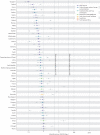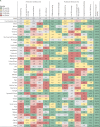Quantifying risks and interventions that have affected the burden of diarrhoea among children younger than 5 years: an analysis of the Global Burden of Disease Study 2017
- PMID: 31678029
- PMCID: PMC7340495
- DOI: 10.1016/S1473-3099(19)30401-3
Quantifying risks and interventions that have affected the burden of diarrhoea among children younger than 5 years: an analysis of the Global Burden of Disease Study 2017
Abstract
Background: Many countries have shown marked declines in diarrhoeal disease mortality among children younger than 5 years. With this analysis, we provide updated results on diarrhoeal disease mortality among children younger than 5 years from the Global Burden of Diseases, Injuries, and Risk Factors Study 2017 (GBD 2017) and use the study's comparative risk assessment to quantify trends and effects of risk factors, interventions, and broader sociodemographic development on mortality changes in 195 countries and territories from 1990 to 2017.
Methods: This analysis for GBD 2017 had three main components. Diarrhoea mortality was modelled using vital registration data, demographic surveillance data, and verbal autopsy data in a predictive, Bayesian, ensemble modelling tool; and the attribution of risk factors and interventions for diarrhoea were modelled in a counterfactual framework that combines modelled population-level prevalence of the exposure to each risk or intervention with the relative risk of diarrhoea given exposure to that factor. We assessed the relative and absolute change in diarrhoea mortality rate between 1990 and 2017, and used the change in risk factor exposure and sociodemographic status to explain differences in the trends of diarrhoea mortality among children younger than 5 years.
Findings: Diarrhoea was responsible for an estimated 533 768 deaths (95% uncertainty interval 477 162-593 145) among children younger than 5 years globally in 2017, a rate of 78·4 deaths (70·1-87·1) per 100 000 children. The diarrhoea mortality rate ranged between countries by over 685 deaths per 100 000 children. Diarrhoea mortality per 100 000 globally decreased by 69·6% (63·1-74·6) between 1990 and 2017. Among the risk factors considered in this study, those responsible for the largest declines in the diarrhoea mortality rate were reduction in exposure to unsafe sanitation (13·3% decrease, 11·2-15·5), childhood wasting (9·9% decrease, 9·6-10·2), and low use of oral rehydration solution (6·9% decrease, 4·8-8·4).
Interpretation: Diarrhoea mortality has declined substantially since 1990, although there are variations by country. Improvements in sociodemographic indicators might explain some of these trends, but changes in exposure to risk factors-particularly unsafe sanitation, childhood growth failure, and low use of oral rehydration solution-appear to be related to the relative and absolute rates of decline in diarrhoea mortality. Although the most effective interventions might vary by country or region, identifying and scaling up the interventions aimed at preventing and protecting against diarrhoea that have already reduced diarrhoea mortality could further avert many thousands of deaths due to this illness.
Funding: Bill & Melinda Gates Foundation.
Copyright © 2020 The Author(s). Published by Elsevier Ltd. This is an Open Access article under the CC BY 4.0 license. Published by Elsevier Ltd.. All rights reserved.
Figures












Comment in
-
Trends in the global burden of paediatric lower respiratory infections.Lancet Infect Dis. 2020 Jan;20(1):4-5. doi: 10.1016/S1473-3099(19)30557-2. Epub 2019 Oct 31. Lancet Infect Dis. 2020. PMID: 31678028 Free PMC article. No abstract available.
-
Early childhood diarrhoea: from data to interventions.Lancet Infect Dis. 2020 Jan;20(1):2-3. doi: 10.1016/S1473-3099(19)30559-6. Epub 2019 Oct 31. Lancet Infect Dis. 2020. PMID: 31678030 No abstract available.

